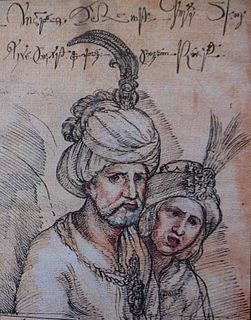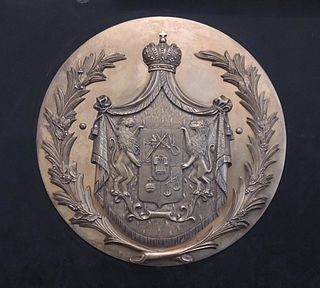
Heraclius II, also known as Erekle II and The Little Kakhetian, was a Georgian monarch of the Bagrationi dynasty, reigning as the king of Kakheti from 1744 to 1762, and of Kartli and Kakheti from 1762 until 1798. In the contemporary Persian sources he is referred to as Erekli Khan, while Russians knew him as Irakly (Ираклий). His name is frequently transliterated in a Latinized form Heraclius because both names Erekle and Irakli are Georgian versions of this Greek name.

Ioane Bagrationi was a Georgian prince (batonishvili), writer and encyclopaedist.

Vakhtang V born Bakhuta Mukhranbatoni was the King of Kartli from 1658 until his death, who ruled as a vassal wali for the Persian shah. He is also known under the name of Shah Nawaz, which he assumed on being obliged outwardly to conform to Islam.

David X (1482–1526) was a king of the Georgian kingdom of Kartli from 1505 to 1525.
Simon II, also known as Svimon or Semayun Khan, was a Persian-appointed king of Kartli, eastern Georgia, from 1619 to 1630/1631.

Mukhrani is a historical lowland district in eastern Georgia, currently within the borders of Mtskheta-Mtianeti region, north of the town of Mtskheta. It lies within the historical borders of Kartli, bounded by the Kura River, and its two affluents: Ksani and Aragvi.

Teimuraz I (1589–1661), of the Bagrationi Dynasty, was a Georgian monarch who ruled, with intermissions, as King of Kakheti from 1605 to 1648 and also of Kartli from 1625 to 1633. The eldest son of David I and Ketevan, Teimuraz spent most of his childhood at the court of Shah of Iran, where he came to be known as Tahmuras Khan. He was made king of Kakheti following a revolt against his reigning uncle, Constantine I, in 1605. From 1614 on, he waged a five-decade long struggle against the Safavid Iranian domination of Georgia in the course of which he lost several members of his family and ended up his life as the shah's prisoner at Astarabad at the age of 74.
The Duchy of Aragvi was an important fiefdom in medieval and early modern Georgia, strategically located in the upper Aragvi valley, in the foothills of the eastern Greater Caucasus crest, and ruled by a succession of eristavi ("dukes") from c. 1380 until being transferred to the royal crown in 1747.

The Kingdom of Kartli was a late medieval/early modern monarchy in eastern Georgia, centered at the province of Kartli, with its capital at Tbilisi. It emerged in the process of a tripartite division of the Kingdom of Georgia in 1478 and existed, with several brief intermissions, until 1762 when Karti and the neighboring Georgian kingdom of Kakheti were merged through a dynastic succession under the Kakhetian branch of the Bagrationi dynasty. Through much of this period of time the kingdom was a vassal of the successive dynasties of Iran, but enjoyed intermittent periods of greater independence, especially after 1747.
Vakhtang the Good was a Georgian royal prince (batonishvili) of the Bagrationi dynasty. He was the first child and the eldest son of Heraclius II, then-prince of Kakheti, born of his first marriage to Ketevan née Orbeliani or, according to more recent research, Ketevan née Pkheidze.

David also known by the hypocorism Datuna was a prince (batonishvili) of the royal house of Kakheti, a kingdom in eastern Georgia. He was the only son of King Teimuraz I of Kakheti to have survived into adulthood. He fathered the future King Heraclius I of Kakheti, who continued the royal line of the Kakhetian Bagrationi. From 1627 until his death in battle with the pro-Persian Georgian ruler Rostom of Kartli, he held sway over the fief of Mukhrani, whose princely rulers had been dispossessed by Teimuraz I.

Darejan or Nestan-Darejan (ნესტან-დარეჯანი) was a daughter of King Teimuraz I, a ruler of Kakheti in eastern Georgia, with a notable role in the contemporary politics of Georgia. Her three marriages represented a component of her family's and her own political machinations. Her first husband, Zurab, Duke of Aragvi, was put to death at the behest of Darejan's father in 1630. Her second and third marriages, to Alexander III and Vakhtang I, respectively in 1630 and 1661, made her a queen consort of Imereti, in western Georgia, where Darejan became embroiled in a series coups and counter-coups. She was eventually murdered by members of the rival party in Kutaisi.
Teimuraz I was a Georgian tavadi ("prince") of the House of Mukhrani, a collateral branch of the royal Bagrationi dynasty of Kartli, and Prince (Mukhranbatoni) of Mukhrani from 1580 until his death. At the same time, he was an ex officio commander of the Banner of Shida Kartli and regent of Kartli, from 1623 to 1625, during the rebellion against Safavid Iran. Teimuraz was killed at the battle of Marabda against the Iranian punitive army.
Constantine I was a Georgian prince and the head of the Mukhrani branch of the royal Bagrationi dynasty of Kartli. He was Prince (Mukhranbatoni) of Mukhrani and ex officio commander of the Banner of Shida Kartli from 1658 to 1667.
Kaikhosro was a Georgian tavadi ("prince") of the House of Mukhrani, a collateral branch of the royal Bagrationi dynasty of Kartli. He was Prince (Mukhranbatoni) of Mukhrani, ex officio commander of the Banner of Shida Kartli, and regent of Kartli from 1625 to 1626. During the civil war in 1626, Kaikhosro sided with Giorgi Saakadze against Teimuraz I of Kakheti and followed him into exile in the Ottoman Empire, where they both, after three years of military service, were accused of treason and put to death.
Papua was a Georgian tavadi ("prince") of the House of Mukhrani, a branch of the royal Bagrationi dynasty of Kartli. He was Prince (Mukhranbatoni) of Mukhrani and ex officio commander of the Banner of Shida Kartli from 1692 to 1696 and Grand Master of the Household (msakhurt-ukhutsesi) at the court of Kartli in 1692.
Ana Orbeliani was a Queen Consort of the western Georgian kingdom of Imereti as the wife of King David II. After David's deposition and death in exile in 1795, Ana tried to secure succession for her son Constantine during the reign of Solomon II, who had supplanted her husband. In her efforts, Ana relied on the Russian Empire, which eventually annexed Imereti in 1810. Ana spent the rest of her life in Russia, where she was known as tsaritsaAnna Matveyevna Imeretinskaya.






















